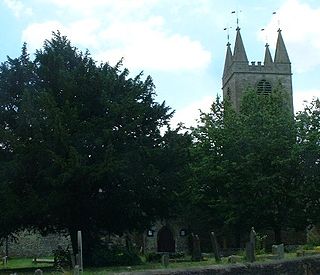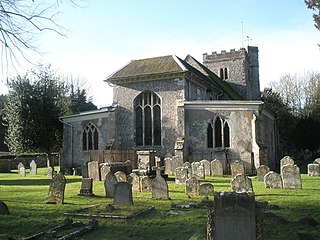
Midsomer Norton is a town near the Mendip Hills in Bath and North East Somerset, England, 10 miles (16 km) south-west of Bath, 10 miles (16 km) north-east of Wells, 10 miles (16 km) north-west of Frome, 12 miles (19 km) west of Trowbridge and 16 miles (26 km) south-east of Bristol. It has a population of around 13,000. Along with Radstock and Westfield it used to be part of the conurbation and large civil parish of Norton Radstock, but is now a town council in its own right. It is also part of the unitary authority of Bath and North East Somerset.

The Parish church of St Michael the Archangel is in the village of Compton Martin, Somerset, England. The church is a grade I listed building, and several of the monuments in the church yard also have listed status., The church is dedicated to St Michael the Archangel.

St John the Baptist's Church is the former cathedral of Chester, Cheshire, England during the Early Middle Ages. The church, which was first founded in the late 7th Century by the Anglo Saxons, is outside Chester's city walls on a cliff above the north bank of the River Dee. It is now considered to be the best example of 11th–12th century church architecture in Cheshire, and was once the seat of the Bishop of Lichfield from 1075 to 1095.

The Church of St John the Baptist, Frome is a parish church in the Church of England located in Frome within the English county of Somerset. It is a Grade II* listed building.

The Church of St Mary Magdalene in Chewton Mendip, Somerset, England, was built in the 1540s and has been designated as a Grade I listed building. It is dedicated to Jesus' companion Mary Magdalene.

The parish Church of St. Quiricus and St. Julietta in Tickenham, Somerset, England, has 11th-century origins, with the nave and chancel being extended by the addition of aisles and the south chapel in the early 13th century. It has been designated as a Grade I listed building.

The Church of St Andrew & St Mary in Pitminster, Somerset, England was built around 1300 and has been designated as a Grade I listed building.

The Church of All Saints in Martock, Somerset, England dates from the 13th century and has been designated as a Grade I listed building.

The Church of St Peter and St Paul in South Petherton, Somerset, England has Saxon origins. It retains a 13th-century crosswing, with the remainder of the buildings dating from the 15th century, however it underwent major restorations in the late 19th and early 20th centuries. It has been designated as a grade I listed building.

The Church of St Andrew in Chew Magna, Somerset, England dates from the 12th century with a large 15th-century pinnacled sandstone tower, a Norman font and a rood screen that is the full width of the church. It is a Grade I listed building.

The Church of St Peter in Marksbury, Somerset, England dates from the 12th century, although most of the current fabric is from the 15th century and is a Grade II* listed building.

The Anglican Church of St John the Baptist in Chilcompton, within the English county of Somerset, was built in the 15th century. It is a Grade II* listed building.

The Anglican Church of St Benedict at Glastonbury within the English county of Somerset was built as a Norman chapel in the 11th century with substantial additions in the 15th and 19th centuries. It is a Grade I listed building.

Christ Church in Clevedon, within the English county of Somerset was built between 1838 and 1839 by Richard Charles Hussey and Thomas Rickman and revised by George Phillips Manners and John Elkington Gill in the 1850s. It is a Grade II* listed building.

The Anglican Church of St Mary the Virgin in Whitelackington, Somerset, England was built in the 14th and 15th centuries. It is a Grade II* listed building.

The Anglican Church of St Peter in Ilton, Somerset, England was built in the 14th century, incorporating fragments from 12th and 13th. It is a Grade II* listed building.

The Anglican Church of St John the Baptist in Horsington, Somerset, England was built in the 15th century and rebuilt between 1885 and 1887. It is a Grade II* listed building.

The Church of St John the Baptist is the Anglican parish church for the village of Bishop's Tawton in Devon. The church has been a Grade I listed building since 1965 and comes under the Diocese of Exeter.

The Anglican Church of St John the Baptist in North Cheriton, Somerset, England was built in the 14th century. It is a Grade II* listed building.

The Church of St Mary and All Saints is an Anglican church in the village of Droxford, in Hampshire, England. It is in the Diocese of Portsmouth, and is one of the churches of the Meon Bridge Benefice. The building is Grade I listed; the earliest parts of the church date from the Norman period.






















